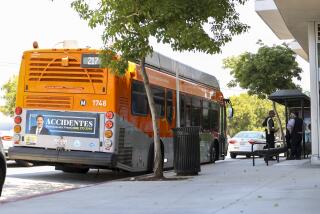Regionalism Gets a Green Light
- Share via
Synchronizing traffic lights on San Fernando Road may sound like a small thing. So small, in fact, that it should have been done years ago. But it wasn’t, and the reason it wasn’t is an object lesson in transportation planning in the Southland.
The busy industrial corridor runs through four cities--Los Angeles, Glendale, Burbank and San Fernando. Each has synchronized the lights on its portion of the road. Hit the lights right on the stretch of San Fernando Road that runs through Glendale, and you’ll sail right along--until you enter Burbank or Los Angeles. The synchronized cities aren’t synchronized with each other.
Time and again, planners and transportation experts have said that Southern Californians need to develop a more regional outlook, from governments on down to residents, if they hope to solve what often seems like hopeless gridlock. San Fernando Road is one example.
The San Fernando Valley Transportation Strike Force recently brought the four cities together to try to come up with a plan to synchronize traffic lights the full length of the road. If the group succeeds, it will be because it took a regional approach.
Valley business leaders formed the group to make sure that something actually gets done with the nearly $500 million from a state traffic relief fund earmarked for the Valley.
Transportation planning has stalled in the past due to indecision over routes and whether to push light rail or buses. And even the $500 million now budgeted for improvements could readily be diverted to the present electricity crisis or some unforeseen emergency if Valley leaders aren’t organized, as former Assemblyman Richard Katz, who co-founded the strike force, points out.
Solutions to the Valley’s traffic problems are not going to be an easy sell. Significantly reducing traffic calls for a comprehensive response: new roads, additional traffic and turn lanes, more mass transit, “smart” fare cards, better traffic signals.
It will involve attacking sprawl by planning developments with more density--fighting words in a region founded on the sanctity of the backyard barbecue--and using or, in some cases, reusing, the land left in the Valley more wisely and more creatively.
And it will involve, above all, a regional outlook. That a group organized to promote Valley interests is talking with its neighbors is a good signal.
More to Read
Sign up for Essential California
The most important California stories and recommendations in your inbox every morning.
You may occasionally receive promotional content from the Los Angeles Times.










